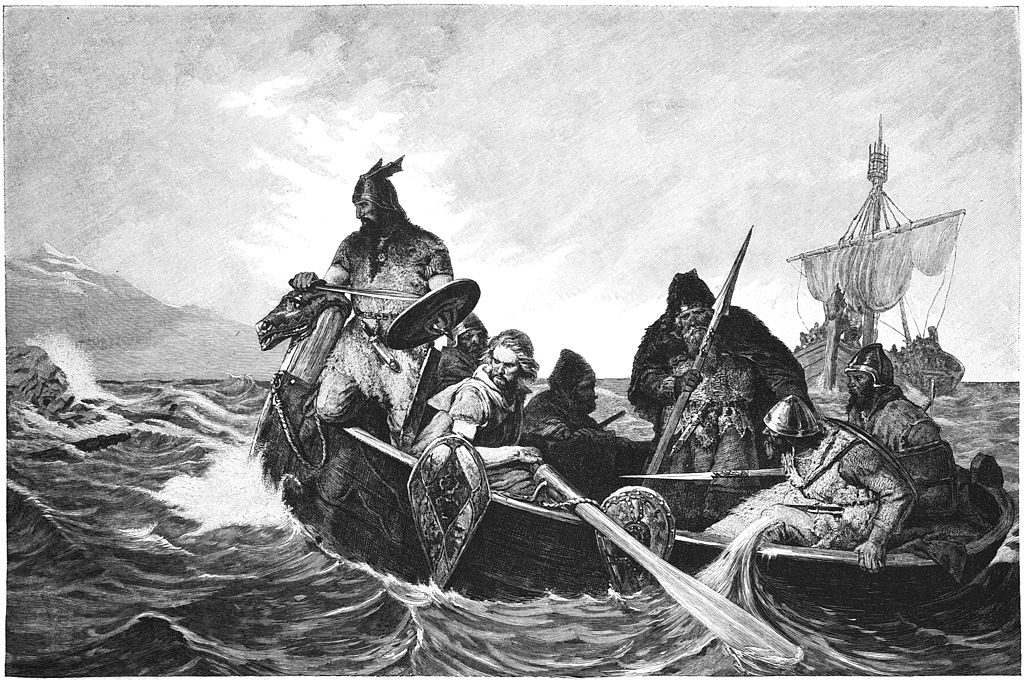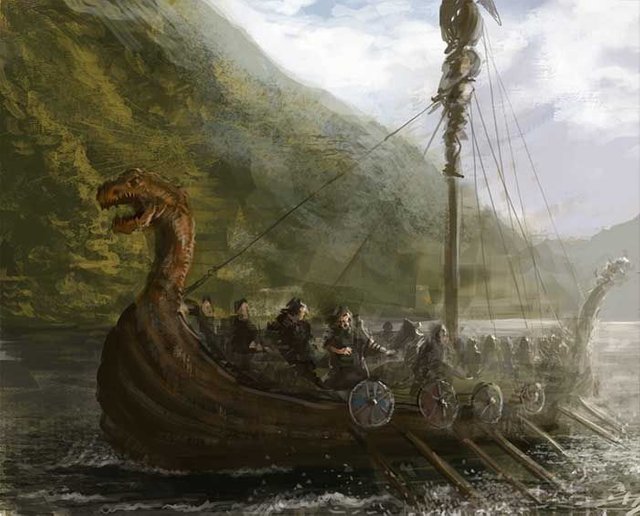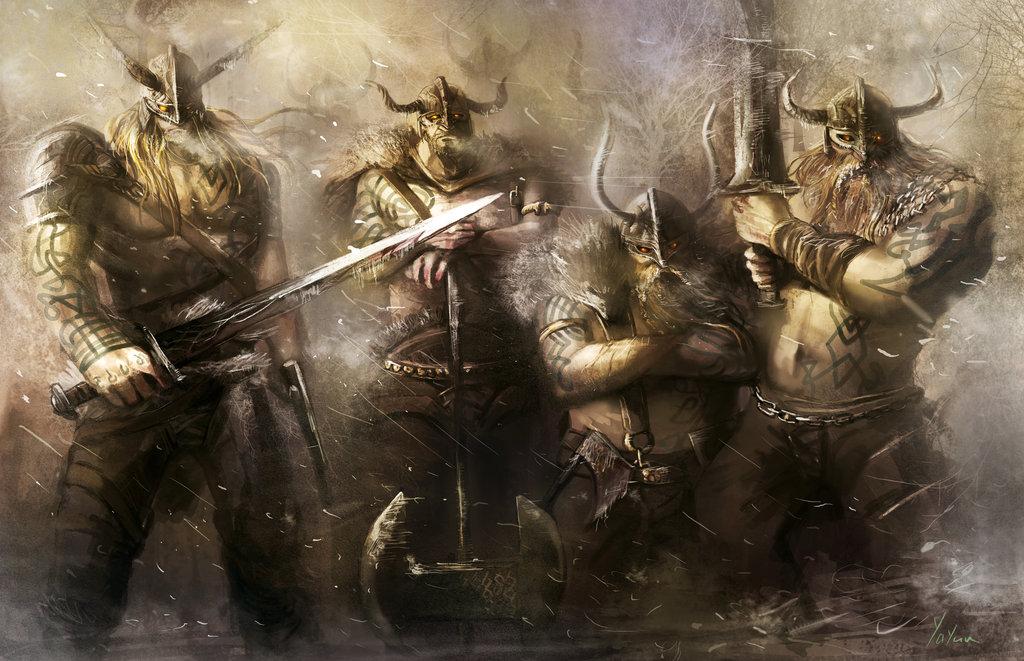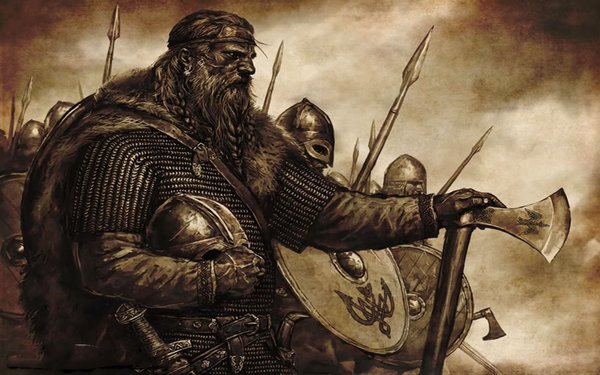Vikings
A Viking (Old Norse Víkingr, plural, víkingar) is an explorer, trader, looter but also Scandinavian pirate during a period extending from the 8th to the 11th century3, commonly known as the "Viking Age". By extension, the term is used in French to refer to the Scandinavian civilization of the Late Iron Age, that is, from the end of the second century to the Roman iron age. They are often called "Normans", that is to say the "men of the North", in the old bibliography.
Unlike the other Germanic peoples of more southern Europe, they remained pagan until the first half of the tenth century. This is one of the reasons why a negative image of their action, reduced to acts of piracy and looting, characterized by the violence of their raids and their pagan barbarism, emerges from European texts from the beginning of the Middle Ages. However, the more contemporary documentation made it possible to qualify the subject and it insists on the positive aspect of their action in certain cases, because they were also great seamen, explorers, merchants and warriors who reached the Atlantic coasts of Europe, the Mediterranean, the East, and even America (Vinland), while at the same time establishing trading posts and colonies, such as those on the Faroe Islands, Orkney Islands, Iceland, Greenland, etc. They founded new and original states in Normandy and Russia5. Their assimilation in the colonized countries proceeds from a deliberate political choice which led to their acculturation in a few decades. The Viking Age ended with the affirmation in Scandinavia of centralizing monarchical powers and their conversion to Christianity.
The word Viking is attested in French in the nineteenth century and in the modern sense means a "warrior, explorer from Scandinavia". Its exact etymology is not assured.
It is mentioned for the first time in old Icelandic form víkingr, then in the forms víkinger, víkingir8.
A widespread etymology makes it a derivative of Norse Vík "cove, cove, inland arm between two islands" 8, also having the original meaning of "place where the earth yields" (derived from the verb vikja "to yield"), d where, by extension, the meaning of "bay", that is to say, cleared place of the coast which allows to dock 9 (see the toponyms like Reykjavik in Iceland or the beaches of Plainvic and Vicq in Cotentin, etc.). This root Vík- is derived using the suffix -ingr (variant -ungr cf old English -ing) meaning "he who belongs to, that of the kind of, the one with the qualities of" 8,10, hence the global meaning by extension of "the one who frequents the coves, the creeks or the inlets" 8.
However, his early 20th-century Old English, in the form of wīcingsċeaða, and Old Frisian, in the form wī (t) sing, suggests a Westian origin of the term. In this case, the radical would in fact represent Old English wīc or Old Frisian wīk both having the meaning of "camp" 8. This last term would have been later reinterpreted into ancient Scandinavian as the word vík.
Indeed, the oldest known uses come from Anglo-Saxon texts of the twentieth century, with the mention of various compounds such as uuicingsceadan, uuicingseadae or saewicingas, all trained on -wīcing-. Their theme is maritime activities, including piracy.
1242/5000
The contemporary Scandinavian texts of the Viking period, for their part, distinguish between a feminine term, víking, which designates activity (fara í víkingu, "those who go on an expedition") and a masculine term, Víkingr (plural, Vikingar), which refers to the Vikings as people. It is likely that these two terms, and that the first, víking, allowed to precisely designate víkingar ("those who go on an expedition"). More recent etymological research, based on existing work, with the presence of the Vika nautical measurement ("distance traveled at sea by two teams rowing alternately"), whose radical vik- would be found in víking, but also in the old English wìcing , the old Frisian wītsing and would all go back to a proto-Germanic of the west * wīkingō ("change of rower") and * wīkingaR deriving from the first and meaning "man rowing alternately", which is conceived at the time when the ships circulating in the North Seas were rowing boats, such as that of Nydam. Subsequently, specific meanings would have been perpetuated: maritime expedition, warrior-sailor, pirate


"Anyone who has seen the boat of Oseberg will never see the ninth century Normans as vile and insensitive barbarians," wrote a historian [Who?] After visiting the Ship Museum in Oslo. Even if it remains imperfect, the knowledge of Scandinavian boats has progressed thanks to the archaeological discoveries of boats. Oseberg's ship, discovered in 1904, is one of the finest preserved specimens to which Gokstad21 and Skuldelev22 can be compared. The iconography, in the foreground the Bayeux Tapestry, provide other information.
There is no Scandinavian model boat. Its architecture varied according to the destination (cabotage trade, long course, war or pageantry) and evolved over time. However, there are some common points. The bow and stern are raised; their hull is built with clapboard. Since the twentieth century, they are propelled by the wind thanks to a rectangular wool sail. This ship goes back very well to the wind23. This does not prevent boats from being equipped with oars as well. Warships, like Gokstad's, are called langskip or snekka24. The term drakkar is a wrong barbarism created in the nineteenth century, inspired by the modern Swedish term "drake" (dragon) - and not "dreki" in Norse - to which a double "k" has been added to accentuate its exotic appearance. The Vikings did not so designate their boat.
Archaeologists recognize the excellent architecture of Scandinavian boats. They are surprised by the flexibility of the hull. The frames are attached to the plating - and not to the keel - by wicker ties, leather laces or, for late models, by pegs25. As a result, the ship can face the high seas writhing to the waves. In addition to flexibility, Viking boats are known for their lightness. The hull is a few centimeters thick. As a result, the draft is weak, giving the impression that the boat slips on the waves. The speed could exceed 10 knots (approximately 18 km / h).

Good
thank you bro
good
thank you bro
Nice
thank you bro
Good job
thank you bro
Good
thank you bro
Good bro
thank you
Good job bro
thank you